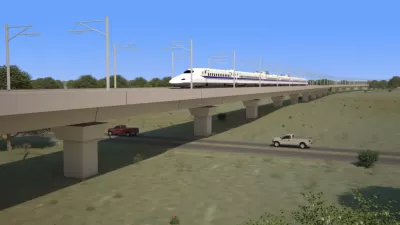The North American High Speed Rail Group has proposed an elevated, $4.2 billion, 150+ mph high-speed rail line above existing highways without public subsidy between Rochester and the Twin Cities. Completion is estimated for 2021.
The private Bloomington-based company, the North American High Speed Rail Group (NAHSR) has completed a preliminary study of a line between Rochester, the state's third largest city (pop. 112,225) and the Twin Cities of Minneapolis and St. Paul, a distance of about 80 miles.
The rail group's study did not reveal any significant problems, reports Heather J. Carlson, Post-Bulletin political reporter.
"Right now, I don't see any final barriers that would stop the project from going forward," Chief Manager Wendy Meadley said.
That's significant because opposition has arisen in Goodhue County. "[T]he county has made their stance very clear with numerous oppositions to the proposed rail line," wrote Gunnar Olson, editor and publisher of the Kenyon Leader on June 27. As is common to these types of large infrastructure projects, a central issue is eminent domain.
In addition, Carlson writes that the "project has faced fierce criticism from some landowners who live along the proposed corridor."
Mazeppa Republican Rep. Steve Drazkowski said he's seen no indication that opposition is dying down.
"The people don't see a need for it," Drazkowski said.
Zip Rail project
The high-speed rail proposal appears to continue what began with Zip Rail, a proposal by the Minnesota Department of Transportation (MnDOT) that would have run in the same 100-mile corridor, left off after MnDOT suspended the project on Jan. 16, although the agency adds that the "NAHSR project is initially much different than the proposed Zip Rail plan."
Private funding a model for U.S. high-speed rail?
The model for the estimated $4.4 billion line that would run from is similar to the privately funded Texas Central high-speed railway linking the 230 miles between the two most populous cities in the Lone State State, Dallas and Houston, in only 90 minutes. That project is estimated to cost $10 billion according to the Texas Department of Transportation. The completion date is projected to be 2021.
NAHSR's Meadley told Reuter's in May, "All the rules relating to public engagement start the day you take public funding."
With private financing, she said, opponents "can't make thousands of public records requests and run the project over."
That comment caught the attention of Bluestem Prairie. "Meadley's hostility to transparency is breathtaking," notes the rural Minnesota blog.
Funds needed
NAHSR "is looking to move to phase two — raising up to $50 million from U.S. investors to fund a detailed feasibility study," adds Carlson for the Post-Bulletin. "The company has recently broadened its money raising efforts, reaching out to investors across the country."
Plus, they are looking abroad.
The company is in negotiations with two countries — China and Japan — over the potential of importing their high-speed rail technology for the project. Representatives from two other countries are flying in to meet with Meadley about the proposal.
Last month, "China Railway, which had agreed to put up $100 million for XpressWest [previously called DesertXpress] to build a 230-mile, 190 mph train from Victorville, Calif. to Las Vegas last September, withdrew from their agreement, primarily due to the inability to use their own trains," notes Planetizen last month.
Like NAHSR, DesertXpress Enterprises, LLC is a private company, but certain federal regulations apply regardless, such as "a federal government requirement that high-speed trains must be manufactured in the United States to secure regulatory approvals," wrote Julie Makinen, a reporter in the Los Angeles Times' Beijing bureau.
Hat tip to National Association of Railroad Passengers Hotline.
FULL STORY: Group pushes ahead with high-speed rail plans

Maui's Vacation Rental Debate Turns Ugly
Verbal attacks, misinformation campaigns and fistfights plague a high-stakes debate to convert thousands of vacation rentals into long-term housing.

Planetizen Federal Action Tracker
A weekly monitor of how Trump’s orders and actions are impacting planners and planning in America.

In Urban Planning, AI Prompting Could be the New Design Thinking
Creativity has long been key to great urban design. What if we see AI as our new creative partner?

King County Supportive Housing Program Offers Hope for Unhoused Residents
The county is taking a ‘Housing First’ approach that prioritizes getting people into housing, then offering wraparound supportive services.

Researchers Use AI to Get Clearer Picture of US Housing
Analysts are using artificial intelligence to supercharge their research by allowing them to comb through data faster. Though these AI tools can be error prone, they save time and housing researchers are optimistic about the future.

Making Shared Micromobility More Inclusive
Cities and shared mobility system operators can do more to include people with disabilities in planning and operations, per a new report.
Urban Design for Planners 1: Software Tools
This six-course series explores essential urban design concepts using open source software and equips planners with the tools they need to participate fully in the urban design process.
Planning for Universal Design
Learn the tools for implementing Universal Design in planning regulations.
planning NEXT
Appalachian Highlands Housing Partners
Mpact (founded as Rail~Volution)
City of Camden Redevelopment Agency
City of Astoria
City of Portland
City of Laramie





























